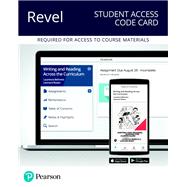For courses in writing across the curriculum.
Writing skills for any major
A best-¿selling interdisciplinary composition text for over 35 years, Writing and Reading Across the Curriculum guides readers through essential college-¿level writing skills such as summary, critique, synthesis, analysis, and research. It provides step-by-step instruction in writing papers based on source materials and includes exercises bridging the gap between reading and writing. An anthology provides cross¿-disciplinary readings on topics that overlap with content from the humanities, sciences, and social sciences. A major revision, Revel Writing and Reading Across the Curriculum, 14th Edition provides new topics, readings, and content on writing and argumentation that address the issues and interests of readers today.
Revel is Pearson’s newest way of delivering our respected content. Fully digital and highly engaging, Revel replaces the textbook and gives students everything they need for the course. Informed by extensive research on how people read, think, and learn, Revel is an interactive learning environment that enables students to read, practice, and study in one continuous experience – for less than the cost of a traditional textbook.
NOTE: Revel is a fully digital delivery of Pearson content. This ISBN is for the standalone Revel access card. In addition to this access card, you will need a course invite link, provided by your instructor, to register for and use Revel.











